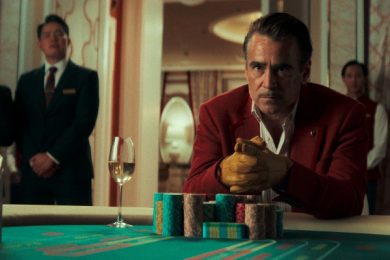Creature comforts are a major motif in Drive My Car. The two main characters of the film feel safest when they’re behind the wheel of a fire engine red Saab, coasting along the highways of metropolitan Japan. One of them habitually listens to a tape, helping him remember the lines of a play he’s going to act in. Another sits quietly, almost pathologically submissive to whomever she may be riding in the car with. Both use the car as a shield against their own feelings, against memories of mental and physical abuse, against grief, against careless infidelities. This vibrantly colored, compact coupe holds in all that they feel inside and choose not to show outside. It’s telling that when these characters choose to trust one another – a rare event for either of them – it is in the Saab, the symbol of their connection.
This is the first Ryusuke Hamaguchi film that I’ve seen. The director, famous for his drawn-out, meditative narratives (his five-hour-plus Happy Hour makes the 179-minute Drive My Car feel like a snack), turns to international best-selling author Haruki Murakami for inspiration here. Based on a short story in Murakami’s collection Men Without Women, Drive My Car departs from the beloved author’s magical realist elements and instead leans fully into the frankness of human emotion, a technique that is both without frills and maximized for full dramatic effect. Seemingly benign acts like driving a car or smoking a cigarette are imbued with overflowing feeling.
Hidetoshi Nishijima plays Yüsuke Kafuku, an actor in Hirsoshima to direct a multi-lingual production of Chekhov’s Uncle Vanya. Yüsuke has played Vanya in previous productions, and he is a veteran of these multi-lingual performances, where actors often don’t know what the other is saying. The process is one of attention and focus, a commitment to line mastery and trust in your fellow partner. Yüsuke finds the experience fulfilling, but he does not plan to act this time around, preferring to be the director and help his performers with this unorthodox theatre style. But there’s another reason he doesn’t want to reprise his performance of Vanya, dealing mostly with his wife (Reika Kirishima), whose intimacy belies infidelity, and who dies of a cerebral hemorrhage early in the film.
Her death haunts Yüsuke for the remainder of the movie, whose own animosity for her behavior only heightens his guilt over her passing. Two years later, Yüsuke still can’t find his way back on stage to perform. His driver, Misake Watari (Töko Miura), has a similar predicament. She’s an expert at her vocation, so steady on the road Yüsuke claims to not even feel gravity as he rides along. Her expertise was crafted by a violent mother, who beat her if her driving was too unsteady. That same mother died in their home during a tragic mudslide, and the conflict of emotions makes Misake almost catatonic in her social interactions. Yüsuke – a man obsessed with the condition and upkeep of his car – is not sure about having a driver (the theatre company’s reasons for demanding it is one of this drama’s many legitimate laughs), but her brilliance behind the wheel quickly sways him.
In between Yüsuke and Misake’s drives, the production of Vanya becomes complicated when he casts the young Köji Takatsuki (Masaki Okada) in the title role, despite the actor being decades too young. Köji has had trouble finding work since being let go by his management company for his undisciplined behavior, and furthermore, Yüsuke knows that Köji is one of his wife’s sexual suitors. It’s difficult to say how much of Köji’s casting is intentional sabotage or a genuine choice for Yüsuke, though Yüsuke is definitely interested in interrogating Köji’s uncontrolled personality, frequently criticizing his choices and performances. The rest of the cast (which includes actors speaking Korean, Mandarin and even one mute actor doing Korean Sign Language), senses the tension between the two, though the source stays unknown.
Hamaguchi crafts a story about people speaking different languages communicating better on stage than the people speaking the same language off of it. Yüsuke’s methods often befuddle his cast – especially Köji – but he pushes them through a communal language of expression. The irony that Yüsuke can’t take this same approach toward expressing his own grief is the key to Drive My Car. His isolation is self-imposed, but his motive is unknown, even to him. Only in meeting Misake – a person equally hardened by life – and seeing the care and affection with which she treats his car, is he willing to face his greatest trauma. There are many great films about overcoming grief, but few that are also about finding connection as well as this.
We learn that Yüsuke and his wife lost a young daughter in 2001, a child who would be Misake’s age if she were still alive today. This is the kind of small detail that goes unremarked upon by the characters, but makes massive impact upon the audience, a brilliant misdirection that Hamaguchi nails multiple times throughout the film. Drive My Car‘s length allows Hamaguchi to maximize the effect of his characters’ subtle frailty, while still refusing to give us all the answers. Led by the performances from Nishijima and Miura, the film waylays its audience with tails of grief, while mesmerizing with moments of immense grace. The balance is a difficult one, but one Drive My Car pulls off brilliantly.
Directed by Ryusuke Hamaguchi










